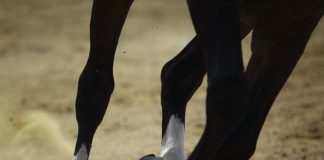
As your horse ages, you may have noticed that he starts out a bit stiffer and creakier in the joints at the beginning of your rides. In fact, as riders get older, many will identify the same phenomenon in their own joints. For years, supplement manufacturers have offered potential remedies for this ailment of aging for both horses and humans, but there has been little definitive research on the effects of these products.
Research from Utrecht University in The Netherlands studied the effects of a compound containing glucosamine, chondroitin sulfate and methyl sulfonyl methane (MSM) on senior horses. These ingredients are commonly used in commercial joint supplements and have shown the potential for anti-inflammatory effects, but have not had much testing in live horses. The researchers used a group of 24 sound horses in their late 20s to early 30s, divided into a test group, which received oral supplements, and a control group that received a placebo. The horses were treated for three months.
The horses were observed for stride length, carpal (knee) flexion, fore fetlock extension and tarsal (hock) range of motion at the walk and trot on a treadmill. At the end of the three month period, the treated horses showed no change in stride length over those in the control group. The control group did show statistically significant improvement in carpal flexion and fore fetlock extension, possibly due to the exercise they experienced as part of the study.
The research does not support the use of this particular compound as an oral supplement to help senior horses. Further research would be required to determine if other ingredients would have better results. However, a potentially more useful takeaway from the study could be the improvement in joint motion in the control group. The researchers suggest that those changes could indicate benefits to an exercise regimen for sound senior horses.
Higler, M. H., Brommer, H., L’Ami, J. J., de Grauw, J. C., Nielen, M., van Weeren, P. R., Laverty, S., Barneveld, A. and Back, W. (2013), The effects of three-month oral supplementation with a nutraceutical and exercise on the locomotor pattern of aged horses. Equine Veterinary Journal. doi: 10.1111/evj.12182
Further Reading
Equine Arthritis
HorseChannel’s Guide to Supplements







cool
Very interesting.
I think the study would be more effective though if it were longer than 3 months. That is, for the supplements. Exercise on the other hand can have immediate and long term benefits as shown here.
Erm, did horsechannel.com actually read the research paper?? Seems to be misreported. Group A got the supplement btw, and is NOT the control group. The control group was Group B.
“The Range of Motion (ROM) of the knee was significant (p<0.05) reduced in group A (-1.2°) and the tarsal ROM was significantly (p<0.05) reduced with time in both groups, but more in group A (-3.3°) than in group B (-o.8°). A reduced ROM means that it is easier for the horse to bring his limb forward.
Fore fetlock maximal extension was significantly (p<0.05) increased in both groups, but more in group A (+ 3.8°) than in group B (+ 1°).
Fore fetlock maximal flexion after maximal extension was significantly (p < 0.05) increased in group A (+4.5°). The significantly differences were only found at walk." "The kinematic data showed that the group of horses and ponies that received the supplement, needed less knee and tarsal ROM and showed more fetlock extension to walk with the same stride duration."